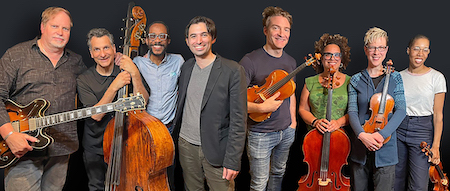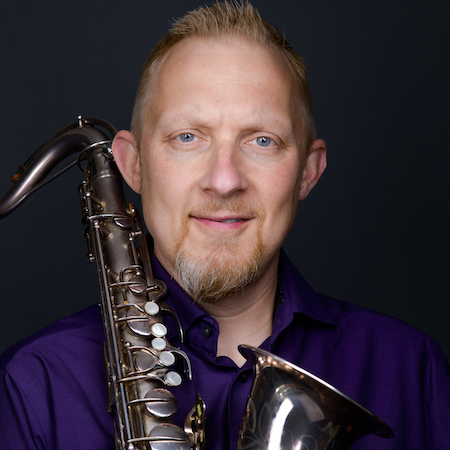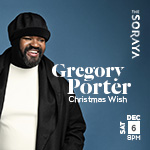Oct 28, 2025 10:47 AM
In Memoriam: Jack DeJohnette, 1942–2025
Jack DeJohnette, a bold and resourceful drummer and NEA Jazz Master who forged a unique vocabulary on the kit over his…

“I wanted to give the strings fun things to play,” Fred Hersch said.
(Photo: Erika Kaplin)Over the past year, the breadth and fire of jazz artists dipping a toe into the classical world has been staggering — from operas by Wayne Shorter and Terence Blanchard to, moreover, a host of musicians releasing jazz-with-strings projects. DownBeat takes a look behind three of these new recordings by Fred Hersh, Dave Stryker and Cory Weeds.
Speaking by phone from his Pennsylvania home, Fred Hersch, one of the most lauded jazz artists of the last three decades, uttered something remarkable: “In the first, at least, 10 to 12 months from March 2020 into the next year,” he confessed, “I really was not that interested in music, honestly.”
Like many others who had their musical careers sidelined by the pandemic, he was “languishing,” despite having all the time in the world, as he recalled in The New York Times describing the mood. “Why practice? I’m not going to play a gig anytime soon. Why write something? I’ll never hear it,” he said forlornly.
Hersch had already made plans to record a new album with a string quartet in May of that year. “In a way, I’m glad it didn’t happen then, because I’m not sure that I would have been ready,” he said. Instead, he got back into music by playing on the piano one song each day for much of the lockdown, streamed live online to share with the isolated world, leading to a solo piano record, Songs From Home (Palmetto, 2020). The pianist called the experience less of a showcase for him than a kind of high-level “comfort food.” As life slowly began to return to at least a semi-functional mode, Hersch realized the break did him some good, considering he had never in his life taken a year off since he started his musical career at age 18. “I feel much more inspired and loose,” he said, “and really into playing, more than I was before lockdown.”
He returned to his string project, which became the new album Breath By Breath (Palmetto), with an initial reading last June with his selected string players, now dubbed the Crosby Street String Quartet, named for the place where they rehearsed. They offered advice on their parts, their edits and markings eventually put into the final revised score. Yet it was apparent to them that the writing was very much in line with the string quartet tradition — no surprise, considering Hersch started listening to that music in elementary school, while lying on the rug of his piano teacher’s studio during rehearsals by her husband, a well-known cellist in Hersch’s hometown of Cincinnati, Ohio. He would start formal composition lessons at age 8, analyzing string quartets by the great masters, from Haydn to Ravel. He also learned to play the violin (“very badly,” in his words) and sang madrigal choral music in high school. “It really got me into this four-voice world,” he said of his early training, “and of course, string quartet is the ultimate four-voice world.”
Hersch’s own pianistic improvisatory style can be traced to those upbringings. He is adept at finding multiple voices in the moment, triggered at times by what he described to this writer and others years ago in a workshop as “the right and left hands interrupting each other.” He acknowledges he is somewhat out of step with a ubiquitous proclivity for virtuosity in jazz, yet his textural pianism translates well to the strings; in many ways, they are just an extension of his entire approach to making music.
“I wanted to give the strings fun things to play, and not just make them play footballs [whole-notes] and backgrounds,” Hersch said of his arrangements. The resultant in-and-out weaving of the rhythm section with the strings adds to the interest and intrigue of the music.
“If you hear all the strings all the time, you don’t hear them anymore,” he explained, stressing he still composes using a pencil rather than a computer program. “I was very conscious of using them when they would have meaning, and not [to] just thrown them in there.” At times, the strings and the piano alternate passages; other times, they mirror each other in texture and articulation. At one point, the strings even provide harmonic background for a bass solo in lieu of the piano.
One striking passage happens in “Mara,” where the violins somehow sound like a Middle Eastern or South Asian instrument, plucking a rhythmic drone while melody and harmony are bowed by cello and viola. The exotic effect was achieved by tapping pencils on the strings. Hersch improvises a free solo over the texture, enhanced by percussionist Rogerio Baccato. The fun for Hersch was getting to interact with the strings in real-time. He wanted to hear and feel the strings while he was improvising and let that sensation govern his choices — as if he were hearing what they were doing for the first time. He elaborated, “My intention was not to think at all about what I was going to play, just to listen in the headphones as they played it and see where it took me.”
Having the string quartet and piano trio in the studio at the same time made for a different type of performance for Hersch. “I don’t particularly love being in the studio,” he admitted. “My playing on the album is very much of a piece with the composition, but it’s really not about me playing in that incredible zone I get into when I’m playing live. I was thinking of being a sort of high-level composer-pianist. My solos were part of the composition. Each piece is very different in the approach I took.” And yet, he conceived all the pieces on the album as a suite, with motifs and key centers aligning to create a unified whole.
This simultaneous inducement of variance and coherence is perhaps what has made him notable not only as a performer, but also as a composer, with many of his works having been performed and recorded by other artists. Hersch, who in 2003 was awarded a Guggenheim Memorial Fellowship for composition, was scheduled to attend a performance at Carnegie Hall in early January by classical pianist Igor Levit performing the world premiere of Hersch’s piece for solo piano, “Variations On A Folksong,” an exploration of the familiar tune “Shenandoah.” That performance will happen mere days after Breath By Breath will have had its week-long debut by Hersch’s trio with bassist Drew Gress, drummer Jochen Rueckert and the Crosby String Quartet at the Village Vanguard. To go from COVID-induced languishing at home to two of the most-hallowed New York performance spaces marks quite a return to public life, even for this celebrated musician.

The opening strains of As We Are, Dave Stryker’s latest album, reveal something not found in the veteran guitarist’s previous 33 albums as a leader. Violins, viola and cello announce themselves with dramatic tremolos, drifting into multiple themes woven throughout all the voices. It could be an excerpt from any of the great 20th century string quartets: Bartók, Ravel, Stravinsky, take your pick.
“Almost everything was modern,” said pianist Julian Shore, in describing the music he researched to arrange the music for Stryker’s album.
“It was Dave’s idea to have an overture,” he continued, speaking via video from his home in Brooklyn. “I thought he was joking when he told me [to write one].” Stryker wasn’t joking. And somehow, Shore was able to encapsulate the themes of the entire album into a piece lasting just over a minute. “I actually wrote that in a really short amount of time,” Shore confessed.
Stryker has known Shore since the pianist was a 14-year-old student in his combo at the Litchfield Summer Jazz Camp in Connecticut. “He had the band drop out,” recalled Shore, “and he pointed to me and said, ‘Stride!’ I didn’t know what to do, and I started playing a bit, and he just goes, ‘No!’”
Shore went from that traumatic encounter to eventually working with Stryker as co-educators for the Litchfield Camp, the two of them forging a friendship that ultimately led to Stryker asking Shore to be the arranger for this dream project. “The first thing we did,” Stryker remembered, on video from his hotel room in Burlington, Vermont, “was to share some recordings we liked. Julian was very familiar with string quartet writing and he thought that would be a cool way to go.” Stryker enjoyed the strings on Keith Jarrett’s 1972 album Expectations (Columbia) as well as those on albums by Wes Montgomery and singers Elis Regina and Shirley Horn. Yet those classic albums often featured an entire string section, providing a lush background, but otherwise detached from the soloists. “We wanted to do something where the string quartet was integrated into the music,” Stryker said.
This introduced another challenge — to maintain a spontaneous, interactive small-group dynamic with the strings. Stryker rounded out the rhythm section with two iconic jazz musicians: bassist John Patitucci and drummer Brian Blade. He chose to have the jazz quartet record a week before the strings, giving the band time to really stretch. “We’re used to working in a quartet format when I record, and the magic that can happen with the four people in the studio,” Stryker explained. “I wanted that to happen with those guys. And it worked out best this way.”
Despite the multi-session format, the strings lock in nicely with the band, thanks in no small part to the jazz-savvy excellence of the ensemble put together by violinist Sara Caswell, who is a friend of Stryker’s, one he considered a must-have for this project. Shore said the string players “all had some background in not only improvising but playing in a jazz setting where things could be kind of flexible and the phrasing is quite different. They were all very polished with that stuff.” An accomplished soloist, Caswell came to the studio a week earlier to record with the jazz quartet.
Stryker said he is ecstatic with the results. “I think it’s one of the best things I’ve done,” he affirmed. “And I think a lot of people would agree that it’s something really different from me. I was able to stretch myself — improvisationally, as a composer, as a collaborator.
“Julian really stepped up to the plate,” Stryker added. He recalled being moved to the verge of tears when Shore sent him the initial demos of the arrangements. “This collaboration with me and him really shows what can happen. To go from a kid who’s 14 years old, who I’m probably scaring, to actually making music together. … That’s what’s beautiful about music. It’s a continuum.”

It’s raining in Vancouver — a common occurrence for any city in the Pacific Northwest, but it’s been exceptionally torrential, souring saxophonist Cory Weeds’ mood. “The world is a mess, in general, and this is just adding to it,” he lamented over the phone. People who grew up in that region identify with that weather-induced worldview. Weeds relates to the global malaise on a personal level. “My life in the jazz business has always been a pandemic,” he cracked. “Jazz is a pandemic. It’s like, ‘Oh, we need to learn how to survive under a bunch of new and crazy circumstances.’ I mean, what a surprise.”
As a saxophonist and a former jazz club owner, Weeds should be forgiven for his rainy-day pessimism, even as he continues to devote his life to improving the artistic lives of jazz musicians in his hometown. Perhaps only a cynical realist could survive the jazz business long enough to become one of the great empresarios of that music in Vancouver (or in any other city). He is at the center of many of the jazz-related happenings throughout British Columbia, producing records for his label — The Cellar Music Group — booking shows, concerts and festivals, often bringing in high-profile talent from New York and elsewhere. One of those artists, baritone saxophonist Gary Smulyan, was invited to Vancouver by Weeds five years ago to perform the music from his album Gary Smulyan With Strings (Criss Cross), planting a seed for a project that ultimately led to Weeds’ own brand-new album with string orchestra, What Is There To Say?
It was years later at a Hank Mobley tribute concert (produced by Weeds) where he thought to have Phil Dwyer become the arranger and co-producer of the album. Dwyer is something of a personal hero to Weeds — he plays saxophone and piano, is a prolific arranger and composer, and he even manufactures musical instruments, including his own saxophone line. Remarkably, he is now working as an environmental law attorney on Vancouver Island, where Weeds’ Hank Mobley tribute was held, the perfect opportunity for Weeds to invite him to play. Knowing Dwyer had already arranged and orchestrated for strings, Weeds asked him if he would be interested in another one.
The two soon began tossing ideas back and forth on a shared online spreadsheet. Weeds sent Dwyer the Smulyan record. “This is what I want,” he told him, envisioning a classic, strings-oriented sound featuring material from the Great American Songbook. Dwyer obliged, producing lush arrangements of some timeless standards and three of Weeds’ originals.
Weeds decided to record the jazz group ahead of time and have the strings record later basing their response on what the band had done. It made sense logistically, but Weeds admitted, “If I could do it again, I probably would have figured out a way where I could have recorded with the strings, just to be in the moment and to be playing with that lush background behind me.” One advantage of having the strings record later was that they could then move the chairs around and re-record the strings to make them sound like a much larger ensemble than the 13 musicians at the session.
All said and done, Weeds loves the results, and others seem to agree. “The response is kind of overwhelming. … I’m very happy with how it’s being received,” he said.
Never one to care about commercial ramifications, he acknowledged the widespread appeal of a string orchestra. “This record has caused a lot of people to reach out to me about all my efforts,” he explained, seeing the attention as affirmation. “It’s very easy to get discouraged. Sometimes it’s like pushing a boulder up the side of a mountain. But at the end of the day, I love the music, and I love the people that make the music.” One must celebrate the occasional rays of light that pierce through those dark and persistent rain clouds. DB

Jack DeJohnette boasted a musical resume that was as long as it was fearsome.
Oct 28, 2025 10:47 AM
Jack DeJohnette, a bold and resourceful drummer and NEA Jazz Master who forged a unique vocabulary on the kit over his…

D’Angelo achieved commercial and critical success experimenting with a fusion of jazz, funk, soul, R&B and hip-hop.
Oct 14, 2025 1:47 PM
D’Angelo, a Grammy-winning R&B and neo-soul singer, guitarist and pianist who exerted a profound influence on 21st…

To see the complete list of nominations for the 2026 Grammy Awards, go to grammy.com.
Nov 11, 2025 12:35 PM
The nominations for the 2026 Grammy Awards are in, with plenty to smile about for the worlds of jazz, blues and beyond.…

Jim McNeely’s singular body of work had a profound and lasting influence on many of today’s top jazz composers in the U.S. and in Europe.
Oct 7, 2025 3:40 PM
Pianist Jim McNeely, one of the most distinguished large ensemble jazz composers of his generation, died Sept. 26 at…

Drummond was cherished by generations of mainstream jazz listeners and bandleaders for his authoritative tonal presence, a defining quality of his style most apparent when he played his instrument unamplified.
Nov 4, 2025 11:39 AM
Ray Drummond, a first-call bassist who appeared on hundreds of albums as a sideman for some of the top names in jazz…






